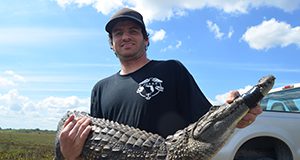South Florida has more nonnative species of reptiles and amphibians than anywhere else in the world. Some of these species become invasive and harm the environment, economy, and/or public health. Once populations are widely established, management becomes expensive, long-term, and often ineffective. Early detection and rapid response offers the best chance to contain or eradicate populations before they can spread and become unmanageable. Toward that end, the Everglades Invasive Reptile and Amphibian Monitoring Program provides a scientific framework for monitoring invasive reptiles and amphibians in south Florida. It also monitors native reptiles, amphibians, and mammals to assess impacts of invasive species.
This 5-page fact sheet written by Rebecca G. Harvey, Mike Rochford, Jennifer Ketterlin Eckles, Edward Metzger III, Jennifer Nestler, and Frank J. Mazzotti and published by the Wildlife Ecology and Conservation Department lists the objectives, activities, and accomplishments of the program over its first five years, and it describes some ways Floridians and visitors to the state can help with the effort.
http://edis.ifas.ufl.edu/uw431
